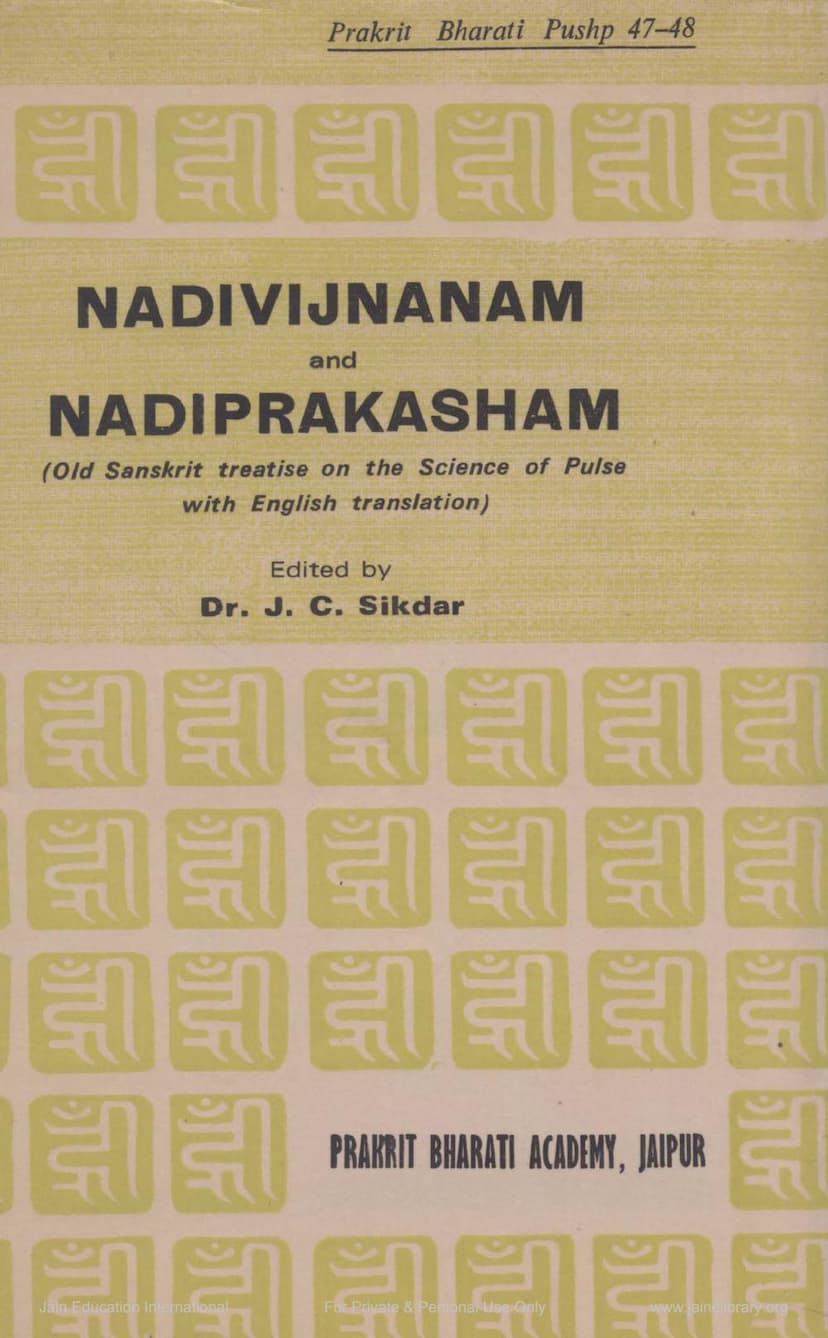Nadivijnanam And Nadiprakasham
Added to library: September 2, 2025

Summary
This comprehensive summary focuses on the provided text, which details two ancient Sanskrit treatises on the science of pulse: Nadivijnanam by Maharshi Kanada and Nadiprakasam by Sri Sankara Sen. Both texts were edited and translated into English by Dr. J. C. Sikdar and published by Prakrit Bharti Academy, Jaipur.
Overall Purpose: The publication aims to bring to light the ancient Indian medical knowledge concerning pulse diagnosis, a fundamental aspect of Ayurveda. It highlights the detailed observations and interpretations of pulse movements to diagnose diseases, predict curability, determine the time of death, and even estimate longevity.
I. Nadivijnanam (Science of Pulse) of Maharshi Kanada:
- Author and Age: Attributed to Maharshi Kanada, a renowned physician and philosopher, author of the Vaisheshika Darshana. He is believed to have flourished in the 7th century BCE, during the Darsanakala (age of Indian Philosophy).
- Content: Composed in 64 Sanskrit verses, it focuses on:
- Pulse Examination: Describes the method of examining six specific pulse points (wrists, ankles, temples) and provides detailed instructions on how to perform the examination.
- Pulse Nature and Diagnosis: Explains how different pulse movements (e.g., speed, quality, rhythm, direction) indicate various diseases, imbalances of the Tridosa (Vata, Pitta, Kapha - air, bile/fire, phlegm/water), and the state of the body.
- Tridosa Correlation: Elaborates on how the pulse movements correspond to the imbalance of Vata (crooked, snake-like), Pitta (restless, crow-like), and Kapha (slow, pigeon-like). It also describes combined Tridosa conditions.
- Disease Indication: Details specific pulse characteristics for numerous diseases, including those related to sexual passion, anger, fear, hunger, fever, indigestion, asthma, cough, cholera, jaundice, and more.
- Curability and Incurability: Predicts the curability or incurability of a disease based on specific pulse patterns.
- Death Prediction: Identifies pulse signs that indicate impending death and the specific timings of death.
- Longevity Prediction: Offers methods to estimate a person's lifespan based on pulse characteristics.
- Auspicious and Inauspicious Signs: Distinguishes between favorable (e.g., purity, steady movement) and unfavorable (e.g., restlessness, hardness, crookedness) pulse symptoms.
- Methodology: The text is written in classical Sanskrit poetry. Dr. Sikdar's editing involved presenting the Sanskrit text with its English translation, adhering to the original spelling and order.
- Relation to Ayurveda: It is considered a significant contribution to Ayurvedic medical science, drawing from accumulated ancient physician experiences. It views Ayurveda as the "fifth Veda."
- Modern Relevance: The editor notes potential parallels between ancient pulse descriptions and modern Homeopathic medicine's understanding of symptomology and drug actions.
II. Nadiprakasam (Light of Pulse) of Sri Sankara Sen:
- Author and Age: Composed by Sri Sankara Sen of Bengal, believed to have flourished in the late 19th to early 20th century AD. He claims lineage from the ancient physician tribe of Ambostoi.
- Content: This work is largely a compilation and clarification of Nadivijnanam, enriched with further material and a Sanskrit commentary. It is divided into three Udyotas (chapters).
- Chapter 1 (9 verses): Focuses on the conceptualization of an imaginary tortoise in the naval region influencing the nervous system and provides methods for pulse examination, including the specific points and times for examination, and the subject matter of diagnosis (Tridosa, curability).
- Chapter 2 (25 verses): Discusses the auspicious and prohibited times for pulse examination, the inherent nature of Vata, Pitta, and Kapha, the meaning of health as indicated by pulse, the specific pulse movements for single and combined Doshas, symptoms of curable and incurable diseases, and the determination of the time of death.
- Chapter 3 (57 verses): Details the rules of pulse examination based on specific diseases, conditions before fever, the nature of fever itself (Vata, Pitta, Kapha fevers, and their combinations), and the pulse indications for various ailments like indigestion, dysentery, chronic diarrhea, piles, worms, jaundice, cough, asthma, insanity, gout, colic, and more. It also covers the impact of diet and lifestyle on the pulse.
- Methodology: Written in Sanskrit verse with a Sanskrit commentary, it was published with a Bengali translation. Dr. Sikdar's English translation aims for clarity. The text references other Ayurvedic sources and incorporates Sen's own knowledge and experience.
- Relationship to Nadivijnanam: Sankara Sen heavily borrowed verses from Maharshi Kanada's Nadivijnanam, often presenting them with added commentary and clarity to make them more accessible to Bengali physicians. While it builds upon Nadivijnanam, it also adds new insights and covers a wider range of conditions.
- Key Features: Emphasizes the determination of the time of death and longevity based on pulse analysis. It also highlights the importance of practice and concentration (like Yoga) for mastering the science of pulse, rather than mere academic study.
Editorial Contribution: Dr. J. C. Sikdar's work in locating these ancient texts, editing them, and providing English translations is crucial for making this specialized knowledge accessible to a wider audience, particularly those interested in the historical and theoretical aspects of Indian medical sciences. The publication is supported by the Government of Rajasthan.